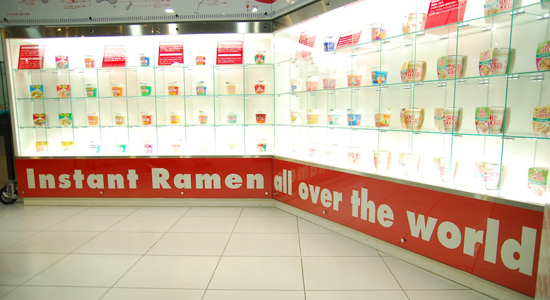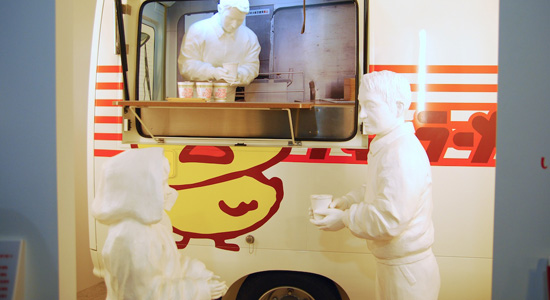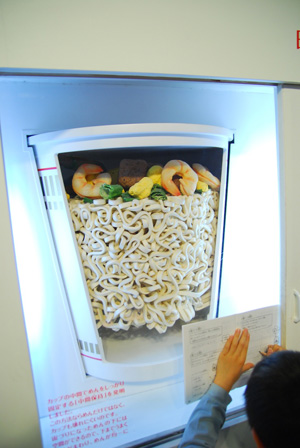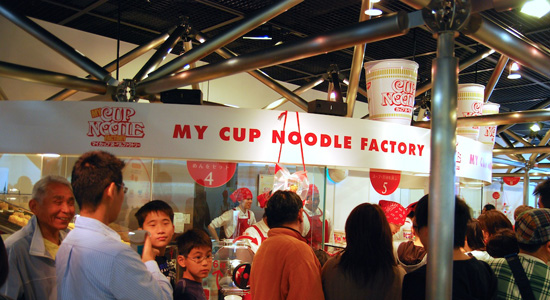
It’s cheap, it’s delicious and it fuels college dorms. It cooks in three minutes and if you put tabasco sauce and lime in it, it becomes down right holy. Yes, we’re talking about Instant Ramen, that import so ubiquitous that many often forget it’s Japanese. Well, kind of anyways. More on that later.

Located in the city of Ikeda in Osaka, it should be noted that while the English name given is the rather plain “Momofuku Ando Instant Ramen Museum,” named for its creator, the Japanese title translates to the more grandiose “Instant Ramen Invention Memorial Hall.” Reinforcing the Serious Business nature of the place is the statue of the aforementioned Ando, which would not look out of place next to Kim Il-Sung on Pyongyang Square.
And the masses come out to pay their respects at the Temple of Soup. Maybe they’re just there for the Golden Week holiday and to be able to make their own flavor of Instant Ramen with the toppings of their choice. But I think we all know better; those freeze-dried shrimp and their brain-controlling chemicals. Can’t trust ‘em.
In all seriousness, the entrance was packed. A two-hour-long-line formed outside the door to the aforementioned Make-Your-Own-Cup-Noodle factory. Fortunately, there was a separate entrance for the museum itself, which was mercifully devoid of such queues. If you could live without a custom-made cup, getting in is as easy as walking through the door – entrance is free and they even have the two films in the museum translated into English and Chinese via an audio accessory which only requires a small deposit that gets promptly returned when finished.

A tourist trap funded by a major corporation, it goes without any surprise the place is largely an exercise in tooting its own horn. The first exhibit is a replica of the shed where Instant Ramen was supposedly perfected as Ando finally figured out the trick to drying noodles. Outside the shack, a film portrays post-war Japan as masses of hungry people lining up around corners and Ando as the hero with the single-minded mantra to feed the world, 3 minutes of boiling water at a time. Never mind that “Chikin Ramen” cost more than anything on the market at the time of its debut.
 Another glaring omission is that of Ando’s Taiwanese origin. Granted, children and families looking to wax nostalgic might not want to be reminded of Japan’s former occupation of Asian territories, but it would have been nice to see some acknowledgement. Instead, we are treated to the kitschy cup as yet another uniquely Japanese invention that only the sun-children of Amaterasu herself could have made with their superior intellects and three alphabets. Bitter? Not I.
Another glaring omission is that of Ando’s Taiwanese origin. Granted, children and families looking to wax nostalgic might not want to be reminded of Japan’s former occupation of Asian territories, but it would have been nice to see some acknowledgement. Instead, we are treated to the kitschy cup as yet another uniquely Japanese invention that only the sun-children of Amaterasu herself could have made with their superior intellects and three alphabets. Bitter? Not I.
Soapboxing aside, it is genuinely fascinating to see how the instant noodle intertwines with Japanese history. From the starvation of post-war period to an international success enjoyed the world over as the bubble started its wild expansion, it is amazing how a food product that has become a fact of life has played a small but integral role in it. One example of this is the computer hub in which you can watch Nissin commercials throughout the ages, including the famous UFO Yakisoba “Upa-lupa” ad whose mascot, the Axolotl, became a popular pet with kids across the nation. Such was its influence that, to this day, they still call those little salamanders Upa-lupa.
On a more serious note, the more humanitarian implications of the noodle on society can be seen in a display just a corner away from the computers. There is a trophy case where, alongside a slightly ludicrous collection of Ando’s favorite items in life (including his iPod Nano for crying out loud), there are many awards he received worldwide for developing this product. Countries from all over the world congratulating on the innovation and ability to actually feed people cheaply.

And it’s fully deserved. The instant noodle, cup and otherwise, is an ingenious little product. After all, it’s easy to make, easy to store and could hold its own with the Twinkie in expiration dates. For all the criticism that could be leveled at this or that, when it comes down to it, it’s just plain neat that this sort of place even exists: a shrine for a rainy day staple that has had a large but subtle impact on us all. It’s kind of nice to have a place to remind us of that. Even if it has to sanctify an iPod in the process.







